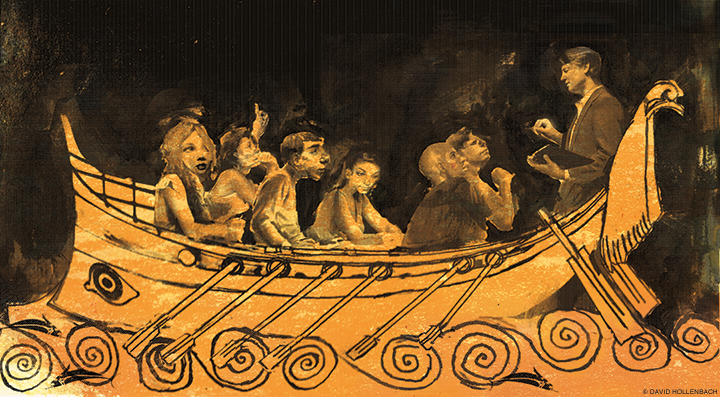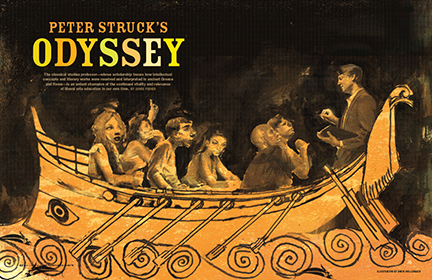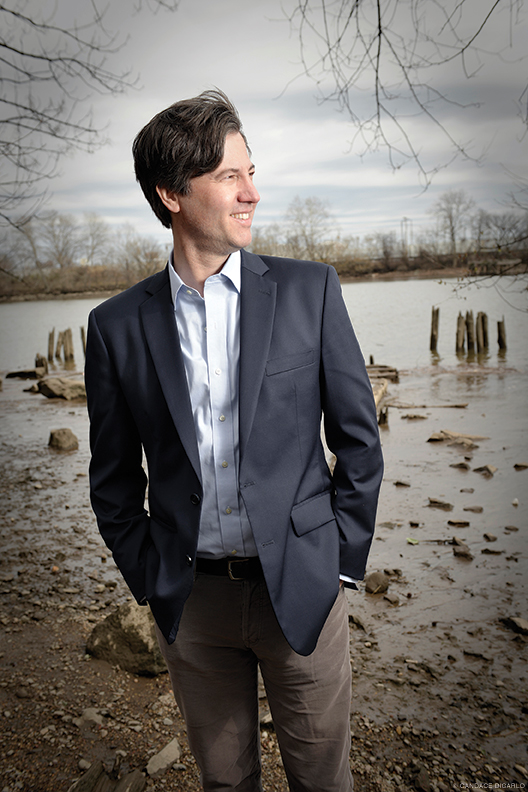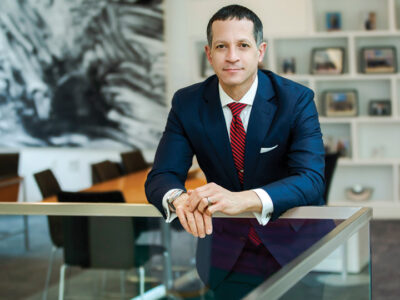
The classical studies professor—whose scholarship traces how intellectual concepts and literary works were received and interpreted in ancient Greece and Rome—is an ardent champion of the continued vitality and relevance of liberal arts education in our own time.
BY JAMIE FISHER
Illustration by David Hollenbach
Photography by Candace diCarlo

Peter Struck is lecturing on The Odyssey.
To be specific, he’s trying to cover Books 9-12 of Homer’s epic about the wanderings of Odysseus in the aftermath of the Trojan War, a stretch that happens to include some of the poem’s most memorable episodes. He has 50 minutes to get through the Lotus Eaters, the Cyclops, Odysseus’s fling with the sorceress Circe, a visit to the Underworld, and the tense navigation between Scylla and Charybdis—effectively a choice between being swallowed whole or being dashed against the rocks. Should any of his students, years down the road, long into their own adult lives and their own particular odysseys, pause to remember Homer’s Odyssey, this is the class they will remember. And Struck knows it.
It’s 11 a.m. in Stiteler Hall, a brisk January day. There are fleece jackets slung over seat-backs, students propping their Moleskine notebooks against thick, annotated copies of the poem on their sidebar desks. Although he’s been reading and teaching Homer for 30 years or so, Struck still sounds genuinely excited as he addresses his students. He encourages them to see The Odyssey as “a search for knowledge—of course he’s learning; when you’re traveling, you’re learning—but he’s also gaining knowledge and skills in more specific ways.”
In his telling, The Odyssey is in part a social-instruction manual, a kind of ancient Greek precursor to Gulliver’s Travels, in which thetitle character is exposed to strange interpretations and misunderstandings of his native culture. Struck calls them “social oddities.”
Consider, Struck says, the Lotus Eaters. They seem human enough. But their behavior—sleeping, lounging, snacking—is too comfortable to be heroic. “You should strive for getting more stuff,” Struck says, “learning more things, becoming well known.” He pauses to write on the chalkboard. “I’ll use a Greek term: kleos.” It means glory.
When Odysseus combats the Cyclops, Struck tells the story with such inquisitive fervor that the puzzles of The Odyssey emerge as a kind of violent chess. Cyclops has trapped Odysseus’s party in a cave, sealed with a boulder only it is strong enough to move, and eaten several members of his crew. How can Odysseus debilitate the Cyclops while still leaving it “in play” so that it can move the boulder and allow Odysseus and his crew to escape before they suffer the same fate?
In his moment of triumph—having blinded the giant and rescued his men—Odysseus tells the Cyclops his name. Struck explains that what we might see as bragging is, in the context of ancient Greek culture, “how you build social capital.”
It’s 11:30 by now, and Struck moves on to Circe. At times, with his earnest, slightly nasal delivery, he’s like a Boy Scout dad telling ghost stories around the campfire. “It’s disgusting,” Struck says of Circe’s cannibalism. “It’s just awwwful.” A moment later, as the sorceress turns Odysseus’s men into pigs, Struck’s comic sensibility seems heavily informed by the cartoon classics of his 1960s childhood. “This always reminds me—and this is a little flippant, but hold with me for a sec—if you know those cartoons, where the wolf is chasing the bunny, and suddenly the bunny in the wolf’s eyes turns into a hotdog?”
Now it’s 11:40—on to the shades in the Underworld. The class is about to end, but Struck still needs to cover Scylla and Charybdis. He has lost some time comparing the Greek afterlife to an airport. He notes that making decisions from a leadership position usually means choosing between two equally bad options. Then his time is up.
“Focus on the cattle!” Struck cries, referring to the upcoming Cattle of the Sun episode, as the undergrads flee to their 12 p.m. class. “The wealth that’s displayed! The importance of food in making social connections!”

With its themes of travel, learning, and combatting insularity, The Odyssey is not a bad place to begin to understand Struck—the Evan C. Thompson Term Professor of Classical Studies and chair of the department, director of the Benjamin Franklin Scholars Program, founder of the Integrated Studies Program, and a Lindback Award winner for his teaching—who in the past 15 years has emerged as one of the nation’s most passionate champions of the liberal arts across a variety of platforms.
Struck is at once the most traditional and radical of professors: enamored of the classics and a staunch defender of the traditional lecture format, but also a passionate advocate for online learning and a thinker quick to find the connections between modern cognitive science and Aristotelian philosophy. He has co-founded a national forum on the future of the liberal arts, given a TED talk on divination, and appeared on T he Diane Rehm Show to explain online education to the longtime public-radio host. He’s served as a consultant for a company making children’s films out of Greek myths and given presentations on Homer to Florida retirees.
Struck first read The Odyssey when he was 18. He remembers having the sense that there was something extraordinarily dense about it, that a person could spend his entire life inside those pages. After graduating from the University of Michigan in 1987 as an English and anthropology major, Struck’s first jobs were in journalism. He copyedited forThe New Republic, fact-checked for U.S. News and World Report. During this period, he also met a personal hero, Lewis H. Lapham, the celebrated and impossibly erudite former editor of Harper’s magazine.
In college, Struck and some friends had created a magazine loosely modeled on Harper’s. When Struck learned that Lapham was starting a second magazine, he got in touch the fastest way he knew—by sending him a fax. “He called me the next day, and we met in Chicago,” Struck recalls. “We talked for three hours over breakfast.”
Together they edited a book that was a prototype for what would become Lapham’s Quarterly, launched in 2007,each issue of which “addresses a topic of current interest and concern—war, religion, money, medicine, nature, crime—by bringing up to the microphone of the present the advice and counsel of the past,” as the publication’s website puts it. Their book was called The End of the World, and included a collection of reading materials on the subject, from the destruction of Pompeii to the near-present. In a way, the timing couldn’t have been better—The End of the World came out in 1997, as worries mounted about the approaching millennium. But then again, Struck acknowledges, “people always think the world is about to end.”
By then Struck had gone back to school at the University of Chicago, earning first a master’s degree in divinity, religion, and literature and then a doctorate in comparative literature. After brief teaching stints at Ohio State and the University of Missouri-Kansas City, he came to Penn in 1999, moving in due course from assistant to associate to full professor of classical studies. He was named chair of the department in 2016.
In hindsight, Lapham provided a bridge between journalism and the academy. His way of thinking, Struck says, is “of a piece with the thing that made me want to be a professor: a curiosity with a very broad reach.” He still works with Lapham today, traveling regularly to New York to collaborate on Lapham’s Quarterly. And Struck remains in awe of the editor, who continues to publish ambitious work at age 82 and whose sense of wonder Struck describes as “hard-won.” “There’s no sentimentality to it,” Struck says. “It’s exactly the quotient of amazement you should have moving through the world.
“That curiosity,” Struck continues, “has been through a lot of cul-de-sacs. When you’re young, you’re curious, but you haven’t been tested yet. The people who’ve been through that, who’ve seen it tested, those are your models.” He thinks for a moment. “I think my reading of The Odyssey probably maps well onto that.”
Around the same time Struck came to Penn, Rita Copeland joined the faculty as a professor of classical studies. In the spring of 2004, Copeland, who was teaching a course on medieval allegory, asked if she could sit in on his senior seminar on Greek literary theory. Copeland—now the Sheila Z. and Burton X. Rosenberg Professor of the Humanities, with appointments in classical studies, English, and comparative literature—marveled at Struck’s teaching style: lucid without notes, colorful without being ludicrous. “He takes the subject that he’s teaching very seriously,” Copeland says, “but he doesn’t take himself very seriously.” She pauses. “He’s also just cool .”
That semester led to a six-year-long collaboration between the two scholars to produce The Cambridge Companion to Allegory. Published in 2010, the book traces a sea change in how we have approached allegory over the centuries, Copeland explains: Considered by the Greeks as a synonym for symbol, by the Romans as a charming form of irony; interpreted by medieval thinkers as a morality play; dismissed by Romantics as “overly mechanical”; and eventually embraced, in the modern period, by thinkers diverse as George Orwell and Walter Benjamin as “a great device for thinking about cultural upheaval.”
More recently, Struck has been engaged in another large-scale collaboration at the invitation of the French Enlightenment historian Sophia Rosenfeld, who joined Penn’s faculty as the Walter H. Annenberg Professor of History this year. The Cultural History of Ideas, due out in 2018 from Bloomsbury Academic, will span from antiquity to the early 20th century in six volumes. Even with Struck handling the pre-modern period and Rosenfeld taking on the Enlightenment forward, that’s still a few odd millennia each—a “daunting” challenge, Rosenfeld says. “It’s more or less a history of everything.”
Part of what excites Struck about The Cultural History of Ideas is what excites him about The Odyssey. It’s a means of looking, in an astonishingly broad context, at cultural values specific to a particular time. The project is organized both thematically and chronologically; when complete, it will be possible to look, say, at the chapter on self in each of the six volumes, or settle down with a cup of Earl Grey and the entire 20th century.
In early discussions, Struck and Rosenfeld engaged in enthusiastic debate over the themes these chapters would explore. Even seemingly universal and capaciouscategories like religion proved simply too narrow, not consistent enough across time. “Ideas for us are always embedded in different social structures,” Struck says. “Cultures have their own core values that they decide are the most important, and we might think there’s a lot of agreement over time, but in fact there’s a change.”
For Homer, the central value was being resourceful; for Virgil, it was piety. “And when we look at modern America,” Struck says, “I think what’s taken to be the best thing you could be is entrepreneurial.” If the Odyssey were written today, it might be the story of a start-up.
The Cultural History of Ideas is a perfect, if perfectly difficult, task for Struck, whose colleagues praise him as a scholar of both range and rigor. Rosenfeld sought him out as someone who was comfortable working with long time-frames and large ideas. And Copeland notes, “I think everyone working in Classics wants to promote the idea of the liberal arts, but there are few people who have a genuine interest in long reception-history, and have the rigor to work on long reception-histories, and Peter is one of them. He can connect the long past to the present.”
There is something decidedly Odyssean about the liberal arts, observes Dennis DeTurck, the Steven A. Levin Dean of the College of Arts and Sciences, Robert A. Fox Leadership Professor, and professor of mathematics. DeTurck believes students shouldn’t “view their education as a transaction but as a journey—just sort of let the story unfold.”
DeTurck first met Struck around 2001, when he was filling in for the faculty master of Stouffer College House and Struck was a faculty fellow in the House. “And so, I got to know him,” DeTurck recalls. “And his wife, and his son, and his dog.” It quickly became apparent that Struck “was interested in the liberal arts writ large,” he adds. “He is a humanist, but he isn’t only concerned about the humanities. He’s concerned about social sciences, economics, the arts.”
After he became dean of the College in 2005, DeTurck approached Struck for help in rethinking the Benjamin Franklin Scholars (BFS) program. BFS had been around for decades, and was originally conceived as Penn’s honors college—but nowadays, as Struck points out, “all of Penn is the honors college.” BFSoffered special seminars to 120 students a year in all four undergraduate schools—the College, Engineering, Wharton, and Nursing—or about 500 students total. But it was no longer entirely clear what BFS was or what it might be.
“The faculty liked it a lot, and the students liked it okay, and what seemed to be missing—Peter really put his finger on it—was there was no sense of cohort. They didn’t know who they were,” says DeTurck. Participating students would take a seminar, “meet someone, and then only see them again three semesters later, if ever. There was no sense of kindred spirit.”
Over lunch at Penne restaurant in the Inn at Penn, DeTurck and Struck began designing what became the Integrated Studies Program (ISP) for students in the College. “We hit pretty early on the idea of an intensive freshman experience,” DeTurck recalls. Columbia had its core curriculum; Chicago, where Struck had earned his graduate degrees, had its Great Books. But DeTurck and Struck felt that their new program needed to be, not a canonical crash course, but an argument for what the liberal arts could achieve.
“Penn has many different messages about why particular programs are important,” Struck says, “but we also needed a strong statement about why the liberal arts are important. So, we brought together introductory courses that related to one another, so they aren’t separate silos of knowledge.” Penn, he adds, isn’t “pre-law, pre-medicine, pre-business—it’s not pre-anything. It’s just Penn.”
In 2009, Struck became director of BFS and the founding director of the ISP. Today, both initiatives are thriving. First-year BFS students from the College live together in Riepe College House in the Quad. Students from all four undergraduate schools participate in ISP seminars that “showcase the value of the liberal arts,” Struck says.
After freshman year, some students have gone on to an integrated living program (ILP) based on the ISP model, located on three floors of the high-rise Harrison College House. “It’s completely student-driven, and it’s sustained itself now for six or seven years,” DeTurck says of the ILP, which is open to all students—evidence that the idea of intellectually engaged communal living has “at least caught the imagination of some folks.”
DeTurck is also working on a capstone experience for seniors in BFS; it will likely involve bringing students together over pizza and films to determine the difference their education has made. And this fall, Struck and ISP associate director Julio Tuma will be starting a seminar for upperclassmen, “The Evolving Self,” that will approach questions of identity from philosophical and biological angles.
As BFS director, Struck has also knit together the various undergraduate schools with a series of joint initiatives, including a faculty council made up of representatives from the four schools. “Peter has really created the umbrella of BFS and drawn us all under it,” says Sarah Kagan, The Lucy Walker Honorary Term Professor of Gerontological Nursing, who directs the nursing school’s program. “He just connects with all BFS students and makes them feel welcome.”
Wharton’s representative, Catherine Schrand, the John C. Hower Professor of Accounting, agrees. Before Struck’s tenure, she says, BFS was “run on inertia.” But, she adds drily, “his goal wasn’t just to keep it running, step down when his term was over, like ‘Thank God, I didn’t ruin it while I was in charge.’” Instead Struck empowered students from all four schools to participate in the shared life of the University: “He welcomed the whole community in.”
“You want to work with Peter to get things done,” Schrand says. “He gives you this feeling like you’re on a team.” (Eminently practical, she also adds: “He doesn’t come in and do anything stupid.”)
Kagan first met Struck a decade ago, at a Center for Undergraduate Research and Fellowships (CURF) function, where they fell into a conversation that “probably had something to do with the philosophy of life or what it means to be human,” she says. In the years since, Kagan, who also serves with Struck on the faculty advisory committee for open learning initiatives, has come to marvel at his talent for leadership—which is, at its core, connected to his ability and eagerness to have a meaningful conversation, she says. “He always has a clear argument and justification for doing something, but wants to hear what we think. He creates a sense of the whole.”
When Struck became chair of the classical studies department last fall, his colleague Rita Copeland remembers, “he wanted to hear what everyone wanted to say about everything, from, ‘Do we have enough paper clips?’ to community outreach. And so, he had everybody over for dinner in little groups of six or seven, a talking dinner where everyone went around the table and Peter wrote down their ideas. And it was almost as if we were in an Integrated Studies Program on what the discipline of the classics should be. Taking it apart, putting it together, and all done with the most extraordinary grace and humility.”
It was also DeTurck who introduced Struck to another major component of his advocacy work for the liberal arts: teaching online. This was around 2001, and the “distance learning program,” called Penn Advance and offered through the College of General Studies (now the School of Liberal and Professional Studies), was “a bit before its time,” says DeTurck.
“We had two chairs and a desk,” Struck recalls of the online mythology course he taught for years, “in what was literally a broom closet that had barely been converted, with a woman from Penn tech pointing at the two of us, and my TA next to me managing the chat room, and we had an 800 call-in line.” He pauses. “And it was great.”
A decade after that makeshift beginning, Struck became part of the first wave of faculty—at Penn or anywhere—to lead a massive open online course (MOOC). In 2012, as podcasts and iTunes University were reaching mainstream popularity, Penn announced a partnership with online education provider Coursera, and Struck began offering his mythology seminar through that platform alongside a handful of professors from fellow partner schools: Stanford, Princeton, and the University of Michigan. Today Coursera offers 1,600 courses through nearly 150 universities to 22 million students worldwide.
In their early days, MOOCs attracted a frenzy of attention and speculation, much of it overblown, but lately they’ve dropped out of the media limelight. “And that’s good,” Struck says. “In the beginning, there was a lot of froth. People were asking, Does this change everything?” (The Gazette’s entry, “MOOC U.,” in the Mar|Apr 2013 issue, wondered if such courses would “spell the end of the university as we know it?”—Ed.)
We’ve come a long way since Struck appeared on Diane Rehm’s public-radio show in 2012, as part of a panel to introduce Coursera. The host seemed somewhat baffled, in a very old-school, public-radio sort of way, not only by online education but by the very idea of the internet. She wondered how the program would work: “How will your lectures be transmitted to hundreds of thousands of students?” She asks, in a concerned way, about “clicks.” But some of Rehm’s questions still have bite. Later in the program, she says, “What happens to the learning institution itself? How does it continue to make money? How does it support professors like Peter Struck? How does it pay for this free education it’s offering to the world?”
“Of course we’re going to give it away for free,” Struck says today, five years later and still impatient for the rest of the world to catch up. “That’s the core mission of academia: once you discover knowledge, you publish it. You make it public. The academy needs to be on the very short list of things that makes a free and democratic society thrive.”
In another effort to advance the liberal arts, from 2009-2012 Struck co-directed the National Forum on the Future of Liberal Education, a three-year program funded by the Teagle Foundation and administered by Penn that offered a series of twice-yearly seminars on best practices in educational theory, practice, and policy designed to prepare younger scholars for future leadership as educators. Topics included online teaching, tools for the modern classroom, and forming more meaningful connections between the university and the broader public. “The Ivies tend to use their resources to fund research, but it’s also important to direct those funds towards teaching,” Struck says. “The point of us being here is not to remove yourself from everything and only write books.”
Jeremy Cohen first met Struck when he was a high-school senior, at a Penn Admissions event for accepted students in Massachusetts. At the time, Cohen says self-deprecatingly, “I didn’t have any background in Latin or Greek or the ancient world, just a much more generic interest—that disgusting 17-year-old interest in learning for learning’s sake, enabled in part by naiveté.”
When Struck spoke, Cohen was immediately drawn in. “He’s fairly quiet, even when he’s projecting,” he says, “which is compelling because you feel like you have to listen intently to what he’s saying, and it feels like it’s worth listening to. He had longer hair back then,and he would part his hair, take off his glasses—hair, glasses, hair, glasses—before answering a question. I wanted to go to a place and learn for its own sake with the most professorial professor.”
Struck’s talk motivated Cohen to come to Penn and participate in ISP. Now a senior, he has completed, under Struck’s supervision, a thesis about a fragment of Plato’s Republic found in the Egyptian desert in the 1940s that had been sealed in a jar along with gnostic Christian texts from the fourth century. Cohen places this find within the context of the Neoplatonic tradition of philosophy that was prominent in the Greco-Roman world during the same period.
Struck approached the idea with some skepticism. “He told me directly that I needed to make changes,” Cohen says. “But he never raises his voice above a hoarse, oracular whisper. So, it’s like, ‘Jesus Christ, Athena came down and told me I have to revise my thesis.’” By Thanksgiving break, Cohen says, “I had a sense that I had written, for the first time, an argument that I really understood.”
Cohen describes his professor in terms that recall Struck’s own description of Lewis Lapham: “always of his time, but also au courant.”
“He talks like he is from a different generation,” Cohen says. “I don’t mean a different generation from me but from his own. He speaks like my grandfather but with the energy of a person from now. When we were working on my thesis last semester, he told me, You gotta write this like you’ve got something stuck in your craw. ”
Asked about his model for what a professor should be, Struck mentions “a string of influences” over the decades. But he speaks about his students, both past and present, with an incredible particularity.
When he went home for Thanksgiving in November, Struck says, he heard some familiar complaints about the younger generation from his extended family: “They think kids are coddled, they shrink from difficulty, all these stereotypes.” He was teaching a BFS seminar on The Iliad last semester, and recalls returning to Penn after the holiday and looking around at the students in the class.
“Let me conjure the table,” he says, after a pause.
What follows is a moment very much like a section familiar to any student of Homer’s epic of the Trojan War: the catalogue of ships, in which the poet appeals to the Muses ( I could not count their numbers nor name them, / Not if I had ten tongues and ten mouths ) before reeling off the 29 contingents setting out for Troy and the soldiers’ 190 places of origin.
“There’s a Wharton kid; an SAS kid; wants to be a creative writer; wants to be a banker; and there’s a conservative Jew; a woman in a hijab; a Singaporean man who has completed his military service; an East Asian woman who is first-generation; one who is second-generation; an Hispanic woman from California; a Kenyan man…” The list goes on.
“And there is,” Struck concludes, “a level of conversation around that table that makes me feel, ‘Okay, the future is fine. Just let these people run the world now.’”
Struck’s first book, Birth of the Symbol: Ancient Readers at the Limits of their Texts, came out in 2004 from Princeton University Press and won the Charles J. Goodwin Award from the American Philological Association for best book in classical studies. It argued that the earliest forms of literary criticism developed, in part, through efforts to understand Homer. “Though these [ancient and modern] readers are likely to concede that the poets work with the mundane stuff of everyday speech,” he wrote in the introduction, “they still hear in their words the faint but distinct promise of some truer resonance, of a subtle and profound knowledge that arrives in a concealed form and is waiting for a skilled reader to liberate it from its code.”
Struck’s recent work continues his inquiry along these lines. In 2016’s Divination and Human Nature: A Cognitive History of Intuition in Classical Antiquity —and in an engaging 14-minute TEDxPenn talk from 2015, available on YouTube—Struck argues for a cognitive basis to divination. Moments of insight, like the ones Malcom Gladwell wrote about in Blink, might be linked to some of the same processes that guided divination in the ancient world. It’s the art of the inexplicable hunch, as sophisticated as it is primal. “There’s a very limited set of things that all humans do,” Struck says. “There’s eating, walking, and there’s divination.”
Struck sees similarities between the early tools of literary interpretation he wrote about in The Birth of the Symbol, with their emphasis on extracting a hidden message, and classical models of divination—attempts to make meaning out of the world.
That same impulse also gives rise to one of the darker aspects of our current political climate—the proliferation of conspiracy theories, interpretation gone disastrously awry. From a classical perspective, the dividing line between sending away to the oracle at Delphi and believing that the Clintons are running a child-sex-slave-powered pizza parlor is improbably thin.
“As humans,” Struck says, “we’re meaning-making machines. Like a bird is hard-wired to build a nest. It’s a way of making the world habitable for ourselves.” Paranoia, he says, is “one of the prices we pay for this amazing capacity for thought.”
Struck also sees a connection between the modern voting process and divination. “In these presidential elections, we’ve got to figure out how to treat every single individual in our society. That’s a huge calculation. And every four years we boil that complexity down to A and B. It’s a bit like drawing rocks,” a popular divination practice.
“Life is confusing,” Struck continues. “And it’s much more complex than we’ll ever figure out. There’s magnificent beauty and terror too. Sometimes there’s a benefit to stepping back and limiting the variables. Divination is a way of limiting the variables. As complex as the situation is, let’s step back and look at this sheep’s liver right now.”
“I cannot quite escape Homer,” says Struck. “Although I haven’t exactly tried.” But while Homer has thoroughly captured his imagination and defined his teaching life—if three decades of evidence is enough to go on—his scholarship looks at Homer only sidelong. For the most part, what Struck likes best is to think about thinking.
In his recent work, from Divination and Human Nature to the BFS course on the philosophy of biology he teaches with Julio Tuma, his lodestar has been not Homer but Aristotle. For generations, Platonists and Christian theologians have lamented the material form as something disposable, something less than real. But for Aristotle, Struck says, it’s not about a true self and false self but “the idea that we have multiple selves sewn together—that’s so much more interesting.”
It’s also central to Struck’s conception of what a liberal arts education can accomplish. “I think there’s much more to say about the fullness of what a human being is than materialism,” Struck says. “I’m trying to get a thicker view of who we are.”
Jamie Fisher C’14 is a freelance writer.




